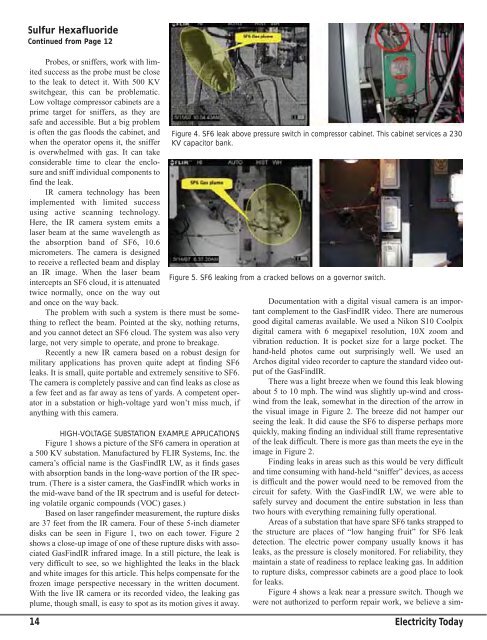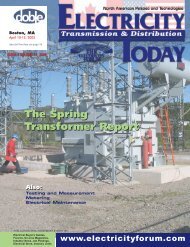in this issue - Electricity Today Magazine
in this issue - Electricity Today Magazine
in this issue - Electricity Today Magazine
You also want an ePaper? Increase the reach of your titles
YUMPU automatically turns print PDFs into web optimized ePapers that Google loves.
Sulfur Hexafluoride<br />
Cont<strong>in</strong>ued from Page 12<br />
Probes, or sniffers, work with limited<br />
success as the probe must be close<br />
to the leak to detect it. With 500 KV<br />
switchgear, <strong>this</strong> can be problematic.<br />
Low voltage compressor cab<strong>in</strong>ets are a<br />
prime target for sniffers, as they are<br />
safe and accessible. But a big problem<br />
is often the gas floods the cab<strong>in</strong>et, and<br />
when the operator opens it, the sniffer<br />
is overwhelmed with gas. It can take<br />
considerable time to clear the enclosure<br />
and sniff <strong>in</strong>dividual components to<br />
f<strong>in</strong>d the leak.<br />
IR camera technology has been<br />
implemented with limited success<br />
us<strong>in</strong>g active scann<strong>in</strong>g technology.<br />
Here, the IR camera system emits a<br />
laser beam at the same wavelength as<br />
the absorption band of SF6, 10.6<br />
micrometers. The camera is designed<br />
to receive a reflected beam and display<br />
an IR image. When the laser beam<br />
<strong>in</strong>tercepts an SF6 cloud, it is attenuated<br />
twice normally, once on the way out<br />
and once on the way back.<br />
The problem with such a system is there must be someth<strong>in</strong>g<br />
to reflect the beam. Po<strong>in</strong>ted at the sky, noth<strong>in</strong>g returns,<br />
and you cannot detect an SF6 cloud. The system was also very<br />
large, not very simple to operate, and prone to breakage.<br />
Recently a new IR camera based on a robust design for<br />
military applications has proven quite adept at f<strong>in</strong>d<strong>in</strong>g SF6<br />
leaks. It is small, quite portable and extremely sensitive to SF6.<br />
The camera is completely passive and can f<strong>in</strong>d leaks as close as<br />
a few feet and as far away as tens of yards. A competent operator<br />
<strong>in</strong> a substation or high-voltage yard won’t miss much, if<br />
anyth<strong>in</strong>g with <strong>this</strong> camera.<br />
HIGH-VOLTAGE SUBSTATION EXAMPLE APPLICATIONS<br />
Figure 1 shows a picture of the SF6 camera <strong>in</strong> operation at<br />
a 500 KV substation. Manufactured by FLIR Systems, Inc. the<br />
camera’s official name is the GasF<strong>in</strong>dIR LW, as it f<strong>in</strong>ds gases<br />
with absorption bands <strong>in</strong> the long-wave portion of the IR spectrum.<br />
(There is a sister camera, the GasF<strong>in</strong>dIR which works <strong>in</strong><br />
the mid-wave band of the IR spectrum and is useful for detect<strong>in</strong>g<br />
volatile organic compounds (VOC) gases.)<br />
Based on laser rangef<strong>in</strong>der measurement, the rupture disks<br />
are 37 feet from the IR camera. Four of these 5-<strong>in</strong>ch diameter<br />
disks can be seen <strong>in</strong> Figure 1, two on each tower. Figure 2<br />
shows a close-up image of one of these rupture disks with associated<br />
GasF<strong>in</strong>dIR <strong>in</strong>frared image. In a still picture, the leak is<br />
very difficult to see, so we highlighted the leaks <strong>in</strong> the black<br />
and white images for <strong>this</strong> article. This helps compensate for the<br />
frozen image perspective necessary <strong>in</strong> the written document.<br />
With the live IR camera or its recorded video, the leak<strong>in</strong>g gas<br />
plume, though small, is easy to spot as its motion gives it away.<br />
14<br />
Figure 4. SF6 leak above pressure switch <strong>in</strong> compressor cab<strong>in</strong>et. This cab<strong>in</strong>et services a 230<br />
KV capacitor bank.<br />
Figure 5. SF6 leak<strong>in</strong>g from a cracked bellows on a governor switch.<br />
Documentation with a digital visual camera is an important<br />
complement to the GasF<strong>in</strong>dIR video. There are numerous<br />
good digital cameras available. We used a Nikon S10 Coolpix<br />
digital camera with 6 megapixel resolution, 10X zoom and<br />
vibration reduction. It is pocket size for a large pocket. The<br />
hand-held photos came out surpris<strong>in</strong>gly well. We used an<br />
Archos digital video recorder to capture the standard video output<br />
of the GasF<strong>in</strong>dIR.<br />
There was a light breeze when we found <strong>this</strong> leak blow<strong>in</strong>g<br />
about 5 to 10 mph. The w<strong>in</strong>d was slightly up-w<strong>in</strong>d and crossw<strong>in</strong>d<br />
from the leak, somewhat <strong>in</strong> the direction of the arrow <strong>in</strong><br />
the visual image <strong>in</strong> Figure 2. The breeze did not hamper our<br />
see<strong>in</strong>g the leak. It did cause the SF6 to disperse perhaps more<br />
quickly, mak<strong>in</strong>g f<strong>in</strong>d<strong>in</strong>g an <strong>in</strong>dividual still frame representative<br />
of the leak difficult. There is more gas than meets the eye <strong>in</strong> the<br />
image <strong>in</strong> Figure 2.<br />
F<strong>in</strong>d<strong>in</strong>g leaks <strong>in</strong> areas such as <strong>this</strong> would be very difficult<br />
and time consum<strong>in</strong>g with hand-held “sniffer” devices, as access<br />
is difficult and the power would need to be removed from the<br />
circuit for safety. With the GasF<strong>in</strong>dIR LW, we were able to<br />
safely survey and document the entire substation <strong>in</strong> less than<br />
two hours with everyth<strong>in</strong>g rema<strong>in</strong><strong>in</strong>g fully operational.<br />
Areas of a substation that have spare SF6 tanks strapped to<br />
the structure are places of “low hang<strong>in</strong>g fruit” for SF6 leak<br />
detection. The electric power company usually knows it has<br />
leaks, as the pressure is closely monitored. For reliability, they<br />
ma<strong>in</strong>ta<strong>in</strong> a state of read<strong>in</strong>ess to replace leak<strong>in</strong>g gas. In addition<br />
to rupture disks, compressor cab<strong>in</strong>ets are a good place to look<br />
for leaks.<br />
Figure 4 shows a leak near a pressure switch. Though we<br />
were not authorized to perform repair work, we believe a sim-<br />
<strong>Electricity</strong> <strong>Today</strong>












